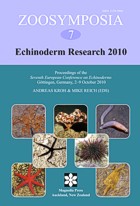Abstract
Reexamination of the type material of the solutan Plasiacystis mobilis from the Šárka Formation (Darriwilian) of Bohemia (Czech Republic) shows that its original reconstruction is a composite, with a mixture of elements belonging to two different solutans, a rhenopyrgid edrioasteroid, and a mitrate stylophoran. The “beaver-tailed” solutan P. mobilis is redescribed, and probable affinities with both Castericystis and minervaecystids are suggested. A second solutan is also described, but left in open nomenclature (solutan indet., gen. et sp. nov.). Possible biological and ecological implications of the presence of an isorophid edrioasteroid (?Agelacrinites bohemicus) attached to the theca of this new solutan are discussed. Other fossil remains formerly assigned to P. mobilis are also described (rhenopyrgid indet. and Mitrocystites mitra). The name “homoiostele” is proposed for the stem-like appendage of solutans. Soluta is reaffirmed as a valid class name (instead of Homoiostelea).

